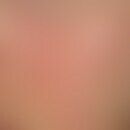Synonym(s)
DefinitionThis section has been translated automatically.
Congenital or acquired thickening and hardening of the nail plate (gr.: pachys= thick), possibly with enlargement and deformation(onychogrypose) as a result of increased and disturbed nail growth.
As a single term for a nail condition the term is not very common. In connection with the congenital "Pachyonychia congenita" it is the eponym. S. a. Scleronychia.
Occurrence/EpidemiologyThis section has been translated automatically.
The symptom Pachyonychia or Onychauxis occurs reactively as an isolated symptom in the following diseases or influences on the skin:
- as a consequence of trauma
- in case of frostbite
- by strong pressure effects on the nail, e.g. by too tight shoes
- in acromegaly
- in Darier's disease
- in psoriasis
- in pityriasis rubra pilaris
Furthermore, the symptom is observed hereditarily associatively in syndromes e.g. in pachyonychia congenita or in combination with diffuse alopecia (Nikoo A 2012).
It has also been described as a non-syndromic autosomal recessive nail dysplasia (syn: Claw-Shaped Nails, NDNC10) due to a mutation in the FZD6 gene (gene locus 8q22.3).
LiteratureThis section has been translated automatically.
- Nikoo A (2012) Pachyonychia congenita-associated alopecia. Case Rep Pathol 2012:850658.
Incoming links (7)
Dentes connati; Genetically caused non-syndromal nail abnormalities; Keratosis follicularis acneiformis, Siemens type; Nail; Nail thickening; Onychauxis; Pachionyxia;Disclaimer
Please ask your physician for a reliable diagnosis. This website is only meant as a reference.



